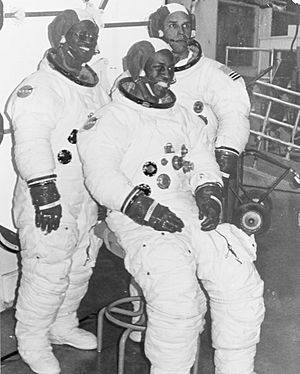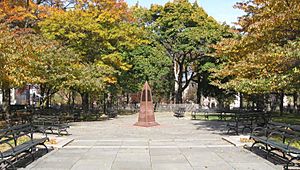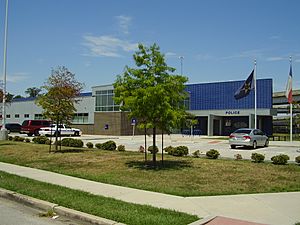Ronald McNair facts for kids
Quick facts for kids
Ronald McNair
|
|
|---|---|
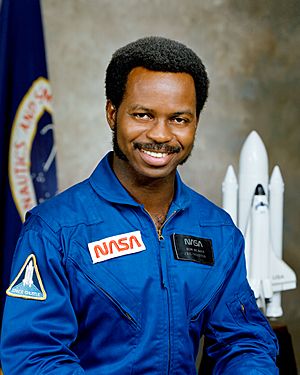
McNair in 1978
|
|
| Born |
Ronald Erwin McNair
October 21, 1950 |
| Died | January 28, 1986 (aged 35) North Atlantic Ocean
|
| Resting place | Ronald E. McNair Memorial Park, Lake City, South Carolina, U.S. |
| Alma mater | |
| Occupation | Physicist |
| Awards | |
| Space career | |
| NASA Astronaut | |
|
Time in space
|
7d 23h 15m |
| Selection | 1978 NASA Group |
| Missions | STS-41-B, STS-51-L (disaster) |
|
Mission insignia
|
|
| Scientific career | |
| Thesis | Energy absorption and vibrational heating in molecules following intense laser excitation (1977) |
| Doctoral advisor | Michael Stephen Feld |
Ronald Erwin McNair (October 21, 1950 – January 28, 1986) was an American NASA astronaut and physicist. He was one of the seven crew members who died during the launch of the Space Shuttle Challenger on mission STS-51-L.
Before this tragic event, he had already flown into space. He served as a mission specialist on STS-41-B aboard Challenger from February 3 to 11, 1984. This made him the second African American and the first Baháʼí person to travel to space.
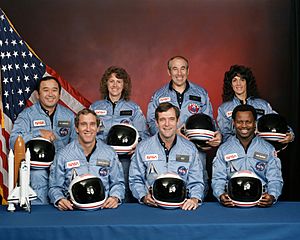
Contents
Early Life and Education
Ronald McNair was born on October 21, 1950, in Lake City, South Carolina. His parents were Pearl M. and Carl C. McNair. He had two brothers, Carl and Eric.
A Childhood Stand for Equality
In the summer of 1959, when Ronald was nine years old, he showed great courage. He went to the segregated Lake City Public Library, where only white people were allowed to check out books. Ronald refused to leave until he was allowed to borrow books.
The police and his mother were called to the library. After some discussion, he was finally allowed to take out his books. Today, the building that once housed this library is named after him, honoring his brave stand. A children's book called Ron's Big Mission tells a story inspired by this event.
Academic Achievements
Ronald was a very bright student. He graduated as the top student from Carver High School in 1967.
In 1971, he earned a Bachelor of Science degree in engineering physics from North Carolina Agricultural and Technical State University. He graduated with high honors. He then continued his studies at the Massachusetts Institute of Technology (MIT).
In 1976, he received his PhD degree in Physics from MIT. He became well-known for his work in laser physics, which studies how lasers work and their uses.
Beyond Academics
Ronald McNair was also a skilled martial artist. In 1976, he won a gold medal in karate. He went on to win five regional championships and earned a 5th-degree black belt.
He received many awards and honors throughout his life. He worked as a staff physicist at the Hughes Research Lab in California. He was also a member of the Omega Psi Phi fraternity and followed the Baháʼí Faith.
Becoming an Astronaut
In 1978, NASA chose Ronald McNair to join their astronaut program. He was one of only 35 people selected from 10,000 applicants! He was also part of a special effort by NASA to include more minority and female astronauts, which was helped by actress Nichelle Nichols.
Ronald McNair's first space mission was STS-41-B aboard the Space Shuttle Challenger. This mission took place from February 3 to 11, 1984. On this flight, he became the second African American to fly in space.
The Challenger Disaster
After his first successful mission, McNair was chosen for the STS-51-L mission. He was one of seven crew members on this flight. The Challenger launched on January 28, 1986.
Tragically, the Space Shuttle Challenger broke apart just 73 seconds after liftoff, nine miles above the Atlantic Ocean. All seven crew members, including Ronald McNair, died in the accident.
He was first buried in Lake City, South Carolina. In 2004, his remains were moved to the Ronald E. McNair Memorial Park, also in Lake City.
Music in Space
Ronald McNair was a talented saxophonist. He had a special project planned for his last space mission.
He was working with the famous composer Jean-Michel Jarre on a piece of music for Jarre's album Rendez-Vous. The plan was for McNair to record his saxophone solo while orbiting Earth on the Challenger. This would have been the first original music ever recorded in space! (Though "Jingle Bells" had been played on a harmonica during an earlier spaceflight).
Sadly, the recording never happened because of the Challenger disaster. The last song on Jarre's album, "Last Rendez-Vous," is subtitled "Ron's Piece." The album notes include a dedication from Jarre, honoring his friend, the astronaut and artist Ron McNair.
Honoring Ronald McNair
Ronald McNair has been honored in many ways since his death.
In 2004, he was given the Congressional Space Medal of Honor. This award was also given to all the crew members who died in the Challenger and Columbia disasters.
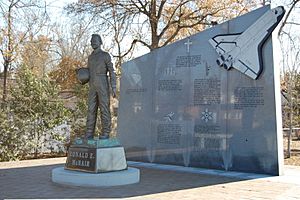
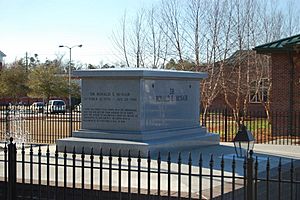
Many places, buildings, and programs are named after him:
- A crater on the Moon is named McNair.
- The McNair Building at MIT, his old university, is named in his honor.
- The McNair Science Center at Francis Marion University in South Carolina.
- The McNair Center for Aerospace Innovation and Research at the University of South Carolina.
- A boulevard in his hometown of Lake City, South Carolina, is named Ronald McNair Boulevard.
- The U.S. Department of Education has a program called the TRIO Ronald E. McNair Post-Baccalaureate Achievement Program. It helps students from low-income families or those who are the first in their family to go to college prepare for advanced degrees.
- On January 29, 2011, the Lake City, South Carolina, library was dedicated as the Ronald McNair Life History Center. This is the same library where he made his brave stand as a child.
- Many schools across the United States are named after Ronald McNair, including elementary, middle, and high schools.
- Parks and public buildings, like the Ronald McNair Park in Brooklyn, New York, and a police station in Houston, Texas, also carry his name.
- The Engineering building at North Carolina Agricultural and Technical State University is named Ronald E. McNair Hall. The university celebrates McNair Day every year.
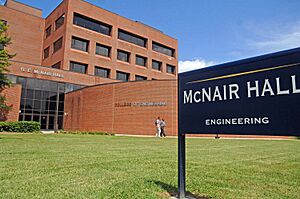
Ronald McNair's story has also been featured in media:
- He was played by actor Joe Morton in the 1990 TV movie Challenger.
- The song "A Drop Of Water" by Japanese jazz artist Keiko Matsui was written as a tribute to McNair.
- The Jean-Michel Jarre song "Last Rendez-Vous" was renamed "Ron's Piece" in his honor.
See also
 In Spanish: Ronald McNair para niños
In Spanish: Ronald McNair para niños
- List of African-American astronauts
- Space Shuttle Challenger disaster
- Rendez-vous Houston



